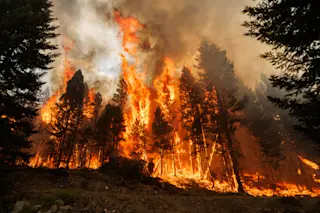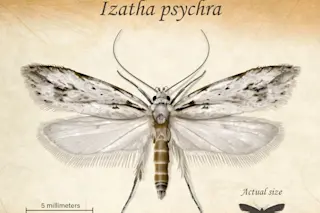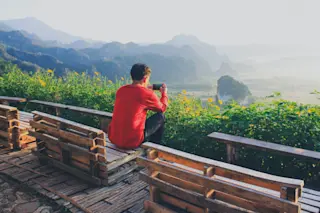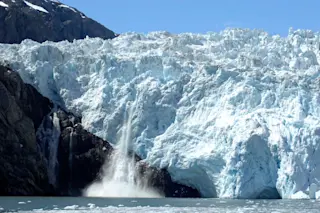On the north coast of the island of Borneo, in a steaming, fetid place called the Pantu peat-swamp forest, I choked on a gnat as beads of sweat slowly rolled down my face. Between my right thumb and index finger dangled several legs that had previously been attached to the unhappy cockroach I held in the fingers of my left hand. I lightly crushed the disabled bug and dropped it into the red-lipped mouth of a Nepenthes bicalcarata plant, commonly known as the fanged pitcher because of a pair of thornlike appendages that protrude from the bottom of the pitcher lid. Then I got down on my hands and knees in the mud and rotting leaf litter and looked at the struggling cockroach through a large magnifying glass to see what would happen next.
Two sharp, saber-toothed fangs hang from the lid of the carnivorous plant Nepenthes bicalcarata, giving it a fearsome appearance. Spiny winged appendages that flank the stem serve as a laddered gateway leading unsuspecting insect prey to the mouth of the fluid-filled pitcher.
"That's cheating," said my companion, Ch'ien Lee, a young American field botanist.
"Enhanced food-chain dynamics," I replied, without taking my eyes from the crippled cockroach.
Ch'ien and I had ventured into the jungle to examine various species of Nepenthes, carnivorous pitcher plants whose natural habitat extends from southern China, Vietnam, and Cambodia to the Philippines, New Guinea, northern Australia, New Caledonia, India, Sri Lanka, Madagascar, and the remote islands of the Seychelles. But the most spectacularly colored and shaped species are found growing as vines on the islands of Borneo and Sumatra, as well as in peninsular Malaysia. The ultimate goal of my journey with Ch'ien was to travel to the remote interior of Borneo in quest of Nepenthes campanulata, the rarest species of carnivorous pitcher plant on Earth. Until quite recently, the plant had not been seen for half a century. It had been collected only once, and the original habitat had been destroyed. Ch'ien discovered a new habitat in 1997, and until recently he was the only person to have photographed the species.
Ch'ien has the intrepid spirit and collecting fervor of the 19th-century naturalist Alfred Russel Wallace. During our first afternoon in the Pantu swamp forest, he spoke earnestly about pitcher-plant prey-trapping strategies, infauna food-web dynamics, pitcher longevity, glandular zones, and leaf-tip morphology. But I wasn't following the drift of his conversation very well because my mind was fully occupied by the floundering cockroach and the life-and-death struggle that was developing in the pitcher before me.
The pitcher was filled with digestive fluids— acids and enzymes that dissolve insect prey so they can be absorbed into the walls of the plant. But as the cockroach struggled in the fluid, a bizarre drama began to unfold. A group of ants came into view just inside the lip of the pitcher and assembled like a well-drilled team of mountain-rescue experts.
Jungle Journey: In northwest Borneo, botanist Ch'ien Lee parked his Land Rover near a hill (A), where he examined carnivorous plants growing on a craggy limestone cliff (B). Farther inland, villagers helped Ch'ien and company navigate the flooded Lutut River (C). The Lutut is a tributary of the Tutoh River (D), which winds through the habitat of Nepenthes campanulata, the world's rarest pitcher plant.
Photographs by Eric Hansen
Camponotus schmitzi ants make their nests in the hollow leaf tendrils of N. bicalcarata. They have attained a certain degree of fame and notoriety among entomologists because of their habit of diving into the fluid of the pitcher to rescue insects much larger than themselves. Peering through my magnifying glass, I watched one ant jump into the fluid to rescue the cockroach, while the other ants clustered at the edge of the "reservoir" and waited patiently for the bug to be brought within reach. For unknown reasons, schmitzi ants are unaffected by the digestive fluid in an N. bicalcarata pitcher. Moreover, entomologists who specialize in ant behavior, including Brian Fisher of the California Academy of Sciences in San Francisco, are mystified as to how the schmitzi ants manage to swim in the fluid and retrieve other insects.
The rescue effort was slow and orderly. Once the diving schmitzi ant brought the cockroach to the edge of the reservoir, the other ants helped carry the wounded insect up the slippery vertical wall of the pitcher to a narrow gallery just beneath the overhanging lip. The ants looked like a group of energetic six-legged rock climbers with toenail-like crampons (known as tarsal claws) trying to move an immense and uncooperative armor-plated creature up a rock wall without the aid of ropes. The arduous two-inch ascent from fluid to resting place took more than an hour. After the team of ants reached the lip of the pitcher, I half expected to see them shake each other's forelegs or lightly slap antennae to congratulate each other for a job well done. Instead, the rescue party pulled the cockroach to pieces and began eating it. The bits they didn't like were tossed back into the pitcher fluid, where mosquito and fly larvae eagerly awaited the leftovers. Remembering the cockroach legs in my right hand, I threw these into the reservoir as well.
When I asked Ch'ien why a carnivorous plant would permit ants to steal food from its pitcher, he told me about a recent study, conducted by Charles Clarke, author of the definitive book Nepenthes of Borneo. After years of observation in the rain forests of Brunei and Sarawak, Clarke concluded that C. schmitzi help prevent N. bicalcarata from overeating.
"Overeating?" I said.
"Too many insect carcasses in the pitcher can upset the chemical balance of the digestive fluid," Ch'ien explained. "This in turn may putrefy and ultimately lead to the death of the pitcher. In exchange for helping to prevent binge eating, the plant provides the ant with free meals plus nesting privileges in the adjoining hollow leaf tendril."
Such unusual symbiotic activity is not unique to N. bicalcarata."Nepenthes lowii has developed a wide mouth, like a trumpet, that helps the pitcher catch falling leaves, which it digests," Ch'ien said. "The pitcher also attracts birds with white sugary secretions. The birds perch on the lip of the pitcher to sip the nectar from special glands, which are strategically located so that the bird must turn its back to the throat of the pitcher. In this way, nitrogen-rich bird excrement will fall directly into the reservoir." Another curious relationship has developed between Nepenthes ampullaria, a lowland species, and the fungus gnat Xenoplatyura beaveri. The gnat larva captures and kills insect prey with deadly droplets of acid, which it deposits on a special net built across the opening of the pitcher. It has been observed, by Clarke and others, that the fungus gnat larva is also capable of fishing small insects from the surface of the digestive fluid.
During our visit to the Pantu swamp, Ch'ien invited me to observe a fight to the death among insects in a pitcher of Nepenthes rafflesiana. "Cannibalistic mosquito larvae ... genus Toxorhynchites ... these little predators are aggressive and rather territorial," he said. For the next half hour, I watched these miniature aquatic gladiators battle one other in a fluid-filled arena no larger than a teacup. Squirming larvae pulled the heads off their fellow insects, bit them in half, and tore the bodies to pieces as they fed on them. Ch'ien said the living larvae would remain unaffected by the fluids in the pitcher, but the body parts of the vanquished swimmers would soon be dissolved and consumed by the plant.
I felt a mild twinge of discomfort as the battle played out. On a previous visit to Sarawak, I visited a village where I was served an unusually delicious lunch of steamed sticky rice and thick coconut milk, flavored with pandan leaves and cooked and served in pitchers of N. rafflesiana.
After spending a couple of days on the coast, I was eager to start our journey upriver, in search of N. campanulata. But Ch'ien was in no hurry. First, he wanted to show me various other Nepenthes species and to share the knowledge he had acquired over the years about their unusual survival strategies. Tropical pitcher plants grow on nutrient-poor soil, rock, or on trees. "The pitcher starts out as a leaf tip and then develops into a tendril with a bud at its distal end," Ch'ien explained. "Then the bud gradually grows in size and slowly inflates with air as it fills with a sterile fluid." Fully formed pitchers thrive on the flesh of a variety of creatures. "I once found a perfect mouse skeleton in a pitcher of N. rafflesiana," Ch'ien said. "But the normal diet of a pitcher plant consists of invertebrate prey, such as ants, cockroaches, termites, crickets, beetles, and occasionally even snails and scorpions. A small insect can be digested by the fluid within a few hours, but it might take a week or much longer to digest a mouse."
The plain lime-green coloring, flared mouth, and diminutive height (three inches) of Nepenthes campanulata make it appear somewhat homely when compared with other tropical pitcher plants. But the plant commonly referred to as the bell-shaped pitcher is coveted by Nepenthes collectors because of its extreme rarity.
Photograph by Eric Hansen
Flying and crawling insects are initially attracted to the pitcher by a fragrance produced by nectar glands that are situated on the bottom of the exposed lid or along the ribbed lip. This sweetly scented lip, known as the peristome, forms the mouthlike entrance to the pitcher. It is often arrayed with a dramatic ring of inward-facing clawlike appendages that help prevent insects from crawling out of the trap. The inner surface of the pitcher is covered with a zone of detachable waxy plates that stop most insects from scaling the walls. The waxy plates clog the insect's feet and prevent them from gaining a grip. Many Nepenthes plants also lure flying insects with a pattern of ultraviolet light on the peristome. This helps ensure that the insect will select a precarious landing zone just above the fluid-filled reservoir.
One afternoon, we hiked into the forbidding maze of jagged limestone hills near the rural township of Bau to look at Nepenthes northiana, one of the largest and most beautifully figured lowland species. A small child's arm can easily fit into a good-sized pitcher of N. northiana. Under ideal conditions, it can grow large enough to hold more than a quart of fluid. Ch'ien noted that collectors had discovered the site and had begun to uproot the plants.
The next day a warm tropical downpour drenched us as we climbed the slick, muddy trail that leads to the summit of Gunung Santubong. We climbed a series of exposed tree roots and fraying rope ladders for nearly three hours before the ground leveled off on top of the mountain. Cold, wet, swirling clouds rolled up and over the craggy summit, but we were rewarded for our efforts by the sight of Nepenthes veitchii growing thickly on wind-sculptured trees. The species has a very pronounced and slightly recurved peristome, which can range in color from bright yellow to brown, green, or red. The peristome can also appear with red-and-green or red-and-white stripes. N. veitchii stems grow straight up tree trunks, climbing to heights of up to 100 feet. Paired leaves hug the tree, like human arms, interlocking tendrils and pitchers for support.
Ch'ien, who had hardly broken a sweat during our ascent, decided to examine some pitchers that hung over a sheer drop. Moving like a tightrope walker, he ventured onto a branch no more than six inches in diameter that bobbed and lurched with every footstep. When he reached the last fork in the branch, he was perched above billowing clouds that hovered over the forest canopy a thousand feet below.
"Ants," Ch'ien said as he crouched down and looked inside a pitcher at the end of the branch. Meanwhile, my armpits moistened at the mere thought of taking such a risk for the sake of determining what a plant had eaten for breakfast that morning.
When Ch'ien and I came down from the mountain, we entered another world. The next day at noon we stood by the edge of a two-lane country road and watched bulldozers moving back and forth over hot, dry, sandy white soil that had previously supported a heath forest. The siliceous, acidic soil was completely cleared of vegetation as the earthmoving equipment leveled the ground for the construction of a new industrial park. A year before, the forest had been home to thousands of lowland Nepenthes plants. Not one pitcher remained. "The plants were bulldozed into a pile and left to die," said Ch'ien. "From a practical point of view, the collection and sale of those Nepenthes species overseas would have easily covered the cost of land clearing."
Since 1995, Ch'ien has managed a Nepenthes nursery for Malesiana Tropicals, a company in Sarawak that propagates rare pitcher plants from seeds that he collects from the wild. The seedlings are exported to commercial growers, hobbyists, botanical gardens, and taxonomists. When I asked how this contributes to conservation, Ch'ien used the story of Nepenthes hamata as an example.
Nepenthes species all feed on insects but are widely varied in appearance. (A) A filamentous "tooth" protrudes from the tip of N. maxima's lid, which hangs over a pitcher six to eight inches tall. (B) N. veitchii, a tree-climbing species, has widely flared lips that resemble the gills of a fish. (C) An oozy white substance secreted in the bristles of N. lowii's lid attracts birds that drop excrement in the pitcher. (D) The lowland species N. rafflesiana has a vaulted lid extended from a tall, spiny neck.
"Until 1996 Nepenthes hamata, which is a showy and rare Indonesian species, was almost unknown in cultivation," he said. "It forms a beautiful pitcher, and its rarity made it highly desirable and very expensive. The few plants available sold for around $300 to $400 each, and this naturally attracted the attention of local plant collectors and foreigners, who started taking these plants from the wild." Ch'ien collected seeds from N. hamata in the wild and germinated them in a laboratory in Sarawak. Five years later, Malesiana Tropicals has more than 500 plants of N. hamata for sale, with many more on the way. As the supply increases, the price is expected to stabilize at around $50 a plant. Ch'ien believes collectors will no longer find it profitable to uproot N. hamata pitchers from the wild. "Who in their right mind would collect wild plants when you can get them legally at such low prices?" Ch'ien says.
On my fifth day in Borneo, we finally set out for the interior of the island. From Kuching, we traveled by light aircraft, four-wheel-drive vehicle, and dugout canoe. When the final tributary river became too shallow and full of rapids, we tied the boat to a tree and hired local villagers to carry our camping equipment and supplies. It took the better part of two days to cut a trail through the dense rain forest vegetation before we came in sight of the remote limestone mountain known as Batu Lagu— "the singing rock." The mountain gets its name from the eerie flute and voicelike sounds created by the winds that blow across the small cave openings on the vertical rock walls. We set up a base camp beneath the jungle canopy, and in the fading light Ch'ien pointed out a towering limestone cliff bathed in an orange glow. This was our destination, and for the next three days we explored the crumbling rock wall, where on a previous visit Ch'ien had discovered N. campanulata.
The species was first identified in 1957 by "Doc" Kostermans, a botanist from the Herbarium Bogoriense in Bogor, Indonesia. But the original habitat, on a remote stretch of the Karangan River in East Kalimantan, was subsequently destroyed by fire. No one had collected seeds, and no plants were in cultivation. N. campanulata (from the Latin campanulatus, which means "bell shaped") had long been thought extinct until Ch'ien spotted it growing high on a Batu Lagu cliff face, nearly 300 miles from where Kostermans had found the original plant. This rediscovery prompted a great deal of excitement in the carnivorous-plant world. Botanists wanted to get their hands on specimens, and commercial growers were intent on being the first to propagate and market the plants. Ch'ien offered to take me to the N. campanulata site on the condition that I would not collect plants or seeds, or reveal the exact location.
As we sat around a campfire at the base camp, one of our porters looked at Ch'ien's photograph of N. campanulata and identified the plant as telor madok. In the local language, this means "the monkey scrotum plant." This is a reference to the shape of the pitcher, but it is also a general term used to describe all species of pitcher plants that grow in the area.
A dissected cross section of Nepenthes maxima reveals ants and other insects in various stages of the digestion process. The plant's prey are attracted to the underside of the lid by nectar and meet their demise if they fall into the fluid-filled pitcher. The upper part of the trap is a waxy zone where the feet of the insects are clogged with a slippery substance. Hundreds of digestive glands in the lower section of the trap secrete acids and enzymes that dissolve the soft parts of the insects, leaving exoskeletons that gradually break apart and accumulate in a graveyard of corpses, where they remain for the life of the pitcher.
At dawn we started up the steep slope strewn with shattered limestone boulders, broken branches, and barbed vines. Two hours later we stood at the base of Batu Lagu. One look at the sheer cliff of slippery, crumbling limestone convinced me that the climb was far beyond my capabilities. So I stood by sheepishly as Ch'ien stepped into his harness, laid out his climbing gear, and began working his way up the cliff face. A light rain started to fall as he set anchors, and one of the porters belayed him. After Ch'ien counted plants and took notes on what the pitchers had been eating, he proceeded to take photos from the most precarious and stomach-churning positions imaginable. Watching his death-defying maneuvers made my heart race, so I looked for a level place at the base of the cliff where I could sit down and calm my nerves with an Indonesian clove cigarette. Within minutes of locating a comfortable place out of the rain, I had the astonishing good luck to discover a single plant of N. campanulata growing at camera-tripod height.
The plant was much smaller than I had imagined. The pitcher was slightly less than two inches wide and three inches high, but the diffuse, overhead light made it glow a pleasant lime- green. I groomed the plant by removing the leaf litter and leisurely took my photos, but I couldn't help thinking how far I had traveled for the sake of this plant. A short while later, Ch'ien rappelled down the cliff face and joined me. We decided to relocate the specimen I'd found to a more inaccessible spot on the cliff face, out of the reach of plant collectors or our guides, should they decide to return later. Ch'ien detached the roots from the limestone with surgical precision, careful to keep the thin layer of clay and root mass intact. Then he free-climbed the cliff and repositioned the plant 40 feet overhead.
A soft, warm rain set in that afternoon as we started the difficult descent through the slippery rock rubble to the foot of Batu Lagu. When we reached camp, the nylon tarp shelters and cot stretchers were knocked down and packed. As we broke camp, I remembered Charles Clarke's comment that Melanesian Islanders thought pitcher-plant fluid smelled like rat urine and that villagers from Brunei used the fluid as a hair oil and styling gel. When I asked the guides about using the pitcher-plant fluid on their hair, they looked at me askance.
"What would our wives think if we put this liquid on our hair?" one of the guides asked. "Too full of dead insects and biting ants . . . and very bad smell."
I had read in The Pitcher Plants of Borneo, by Anthea Phillips and Anthony Lamb, that pitcher-plant fluid was also used as a burn ointment and skin moisturizer and could soothe eye inflammations. None of the men had heard of these uses. So I asked if they had any other special use for pitcher plants. The guides discussed the matter for a few minutes before one man spoke out: "The monkey scrotum plant is useful to us because it brings foreign people to the forest. These people give us money to carry their things so that they can look at the plants."
Plants on Acid
Flesh eating is a surprisingly widespread practice in the plant kingdom. There are more than 500 species of carnivorous plants around the world, and many have evolved independently from one another. What they all have in common is a fight for survival in acidic soils— heaths, bogs, swamps— or sandy shores, environments in which nitrogen and other nutrients are either unavailable or scarce. Most of these flesh eaters can photosynthesize as other plants do, but they depend on insect prey to supplement their diets. Some carnivorous plants, including the Nepenthes species in Borneo, secrete sticky substances onto delicate tentacles— or into watery pitchers— that trap, and in most cases, digest, alighting insects. Others, like the Venus's-flytrap, Dionaea muscipula, have fanged jaws (A) that squeeze tight around their prey. Even more aggressive is Utricularia longifolia (B), one of a carnivorous variety that captures dinner by literally sucking it into an internal digestive chamber. And Drosera paradoxa (C), a plant in the sundew family, combines both passive and active approaches. It first captures insects on slender, sticky tentacles; then the tentacles on the blade move, effectively trapping the prey inside. — Sarah Richardson
Nepenthes species all feed on insects but are widely varied in appearance. (A) A filamentous "tooth" protrudes from the tip of N. maxima's lid, which hangs over a pitcher six to eight inches tall. (B)[not shown] N. veitchii, a tree-climbing species, has widely flared lips that resemble the gills of a fish. (C) An oozy white substance secreted in the bristles of N. lowii's lid attracts birds that drop excrement in the pitcher. (D) The lowland species N. rafflesiana has a vaulted lid extended from a tall, spiny neck.
Photographs: (left), Jeremy Burgess/SPL/Photo Researchers; (right), Barry Meyers-Rice
Malesiana Tropicals in Kuching, Sarawak, Malaysia, is a reliable source of nursery-grown pitcher plants (telephone: 60 82 419 290; fax: 60 82 423 494; www.malesiana.tropicals.com.my). Another good Web site is hosted by the International Carnivorous Plant Society at carnivorousplants.org.














